“Verliere ich meine Google-Rankings, wenn ich meinen Blog umziehe?” Das ist die häufigste Frage, die wir hören, wenn jemand über einen Wechsel von Blogger zu WordPress nachdenkt.
Wir verstehen das – aber nachdem wir unzähligen Bloggern bei dieser Umstellung geholfen haben, können wir Ihnen mit gutem Gewissen sagen: Es ist absolut möglich, von Blogger zu WordPress zu wechseln, ohne Ihre Google-Rankings zu opfern.
Im Laufe der Jahre haben wir den Migrationsprozess verfeinert, um Ihre SEO zu schützen, während Sie auf eine leistungsfähigere Blogging-Plattform upgraden. Durch Versuch und Irrtum haben wir genau herausgefunden, was Sie tun müssen (und was Sie vermeiden sollten!), um Ihren hart verdienten Platz in den Suchergebnissen von Google zu schützen.
In diesem Leitfaden führen wir Sie durch unsere bewährte Methode für den Wechsel von Blogger zu WordPress. Sie werden genau die gleichen Techniken lernen, mit denen wir unzähligen Bloggern wie Ihnen geholfen haben, ihre Websites zu upgraden, ohne ihre Sichtbarkeit in den Suchmaschinen zu beeinträchtigen.

Warum von Blogger zu WordPress wechseln?
Sie verwenden derzeit Blogger, eine beliebte, von Google erstellte Blogging-Plattform, mit der jeder mit seinem Google Konto einen kostenlosen Blog erstellen kann.
Für viele ist es ein großartiger Ausgangspunkt, aber viele Anfänger stellen schnell fest, dass ihr kostenloser Blogger-Blog sich ein wenig begrenzt anfühlen kann. Vielleicht wünschen Sie sich, Sie könnten mehr tun.
Genau hier kommt WordPress ins Spiel. Im Gegensatz zu Blogger haben Sie mit WordPress.org die vollständige Kontrolle über Ihre Website. Außerdem können Sie die notwendigen Funktionen hinzufügen, um Ihren Blog zu erweitern und online Geld zu verdienen. Und wenn es darum geht, von Google wahrgenommen zu werden, können Sie mit WordPress.org alle wichtigen SEO-Optimierungen vornehmen, um Ihre Rankings zu verbessern.
🌟 Möchten Sie mehr Informationen? Wir haben einen detaillierten Vergleich zwischen WordPress und Blogger zusammengestellt, damit Sie alle Unterschiede sehen können.
Unseren Forschungsstatistiken zufolge ist WordPress die beliebteste Website-Plattform der Welt und macht fast 43 % aller Websites aus.
Wenn Sie sich also für WordPress entscheiden, schließen Sie sich Millionen anderer erfolgreicher Websites an. Sie entscheiden sich für eine Plattform, der viele Menschen vertrauen und die sich perfekt für die Präsentation Ihrer Inhalte eignet.
Allerdings gibt es zwei Arten von WordPress-Software, daher ist es wichtig, die richtige auszuwählen.
An erster Stelle steht WordPress.com, ein gehosteter Website-Baukasten. Bei WordPress.com müssen Sie sich nicht selbst um einen Hosting-Plan kümmern und die Software nicht selbst installieren. Stattdessen können Sie einen kostenlosen Plan wählen oder einen der verfügbaren kostenpflichtigen Pläne kaufen, und Automattic wird Ihre Website für Sie hosten.
Dann gibt es noch WordPress.org, das auch als selbst gehostetes WordPress bekannt ist. Wir empfehlen immer, WordPress.org zu verwenden, weil Sie im Gegensatz zu WordPress.com nicht für einen teuren Plan bezahlen müssen, um Plugins zu installieren (betrachten Sie sie als Add-ons für Ihre neue WordPress-Website!).
Schauen wir uns also an, wie man richtig von Blogger zu WordPress wechselt und dabei die Google-Suchergebnisse und den Website-Traffic beibehält.
Hier sind alle Schritte, die wir abdecken werden, um Ihren Umzug von Blogger zu WordPress reibungslos und SEO-freundlich zu gestalten:
- Step 1. Sign up for WordPress Hosting
- Step 2. Export Your Blogger Blog
- Step 3. Import Blogger to WordPress
- Step 4. Setting Up Permalinks
- Step 5. Set Up Redirects From Blogger to WordPress
- Step 6. Moving Other Content From Blogger to WordPress
- Step 7. Things to Do After Migrating From Blogger to WordPress
- Video Tutorial
Sind Sie bereit? Dann fangen wir an.
Schritt 1: Registrieren Sie sich für WordPress Hosts
Um mit WordPress zu beginnen, benötigen Sie einen Domainnamen und ein Webhosting.
Zur Erinnerung: Ein Domain-Name ist die Adresse Ihrer Website, die man eintippt, um zu Ihrem Blog zu gelangen, und das Webhosting ist der Ort, an dem die Dateien Ihrer Website gespeichert sind. Beides ist ein MUSS für jede Art von Blog oder Website.
Wir empfehlen daher Bluehost. Bluehost ist eines der größten Hosting-Unternehmen der Welt und ein offiziell empfohlener WordPress-Hosting-Partner.
Da WPBeginner die größte Website für WordPress Ressourcen ist, haben sie zugestimmt, unseren Besuchern einen kostenlosen Domainnamen und einen 60%igen Rabatt auf das Hosting anzubieten. Im Grunde können Sie für nur 1,99 $ pro Monat loslegen.
Wenn Sie eine Bluehost-Alternative bevorzugen, dann empfehlen wir entweder SiteGround oder Hostinger, da beide ausgezeichnete Lösungen sind (wir nutzen SiteGround, um WPBeginner zu hosten!)
Sobald Sie sich für das WordPress-Hostingpaket angemeldet und Ihren Domainnamen eingerichtet haben, können Sie mit der WordPress-Installation fortfahren.
Wenn Sie sich bei Bluehost über unseren obigen Link anmelden, wird WordPress automatisch für Sie installiert.
Wenn Sie einen anderen WordPress-Hosting-Anbieter verwendet haben, müssen Sie WordPress installieren, indem Sie unsere ultimative Anleitung zur Installation von WordPress befolgen.
Nachdem Sie WordPress installiert haben, ist es an der Zeit, Ihre Inhalte von Blogger zu WordPress zu übertragen.
🧑💻 Wir haben Sie laut und deutlich gehört! Weil so viele von Ihnen danach gefragt haben, freuen wir uns, Ihnen mitteilen zu können, dass wir jetzt einen völlig KOSTENLOSEN Dienst für die Migration von Blogger zu WordPress als Teil unserer kostenlosen WordPress-Blog-Einrichtung anbieten! Das ist richtig – einer unserer Experten wird alles für Sie erledigen, kostenlos. Sie können buchstäblich von Blogger auf die leistungsstarke Welt von WordPress umsteigen, ohne Probleme oder Risiken einzugehen.
Unser kostenloser Blogger-Migrationsdienst ist ideal für kleinere Blogs mit weniger als 1000 Beiträgen. Wenn Sie eine größere Website in Blogger haben, machen Sie sich keine Sorgen! Wir können Ihnen trotzdem bei der Migration helfen, aber das wäre ein kostenpflichtiger Dienst.
Schritt 1: Exportieren Sie Ihr Blogger-Blog
Als Erstes müssen Sie den Inhalt Ihres Blogger-Blogs exportieren. Rufen Sie dazu die Blogger-Website auf und melden Sie sich bei Ihrem Konto-Dashboard an.
Gehen Sie dann zur Seite Einstellungen. Scrollen Sie nach unten zum Abschnitt “Blog verwalten” und klicken Sie auf die Schaltfläche “Inhalt sichern”.
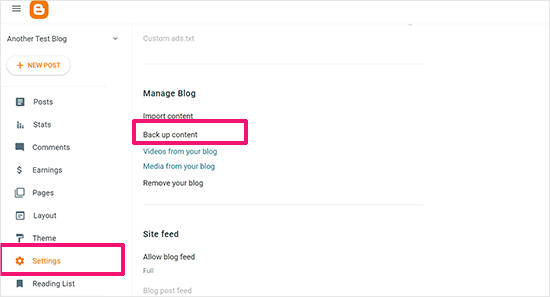
Daraufhin erscheint ein Popup-Fenster, in dem angezeigt wird, was genau in der Blogger-Sicherung enthalten ist.
Um fortzufahren, müssen Sie auf die Schaltfläche “Herunterladen” klicken.

Der Inhalt Ihres Blogger-Blogs wird in einer XML-Datei auf Ihren Computer heruntergeladen.
Sobald der Download abgeschlossen ist, können Sie Ihre Blogger-Inhalte in Ihre WordPress-Website importieren.
Schritt 2: Blogger in WordPress importieren
Um mit dem Import Ihrer Blogger-Site in WordPress zu beginnen, melden Sie sich in Ihrem WordPress-Administrationsbereich an und besuchen Sie Tools ” Importieren.
Klicken Sie auf der Import-Seite auf den Link “Jetzt installieren” unter Blogger.

WordPress wird nun das Blogger-Importer-Plugin für Sie herunterladen und installieren.
Sobald die Installation abgeschlossen ist, müssen Sie auf den Link “Importer ausführen” klicken, um fortzufahren.

WordPress wird Sie auf dem Bildschirm Blogger importieren auffordern, die XML-Datei hochzuladen. Dies ist die Datei, die Sie in Schritt 1 heruntergeladen haben.
Klicken Sie einfach auf die Schaltfläche “Datei auswählen” und laden Sie die XML-Datei hoch, die Sie zuvor heruntergeladen haben.
Klicken Sie anschließend auf die Schaltfläche “Datei hochladen und importieren”, um fortzufahren.
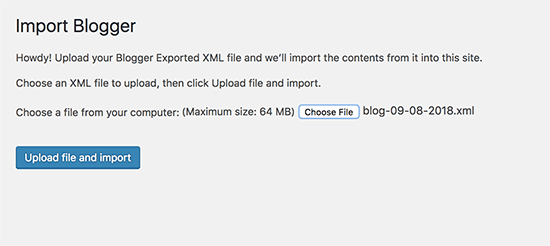
WordPress wird nun die Importdatei hochladen. Wenn Ihre Importdatei zu groß ist, wird möglicherweise eine Fehlermeldung angezeigt.
In diesem Fall müssen Sie die Höchstgrenze für den Datei-Upload erhöhen. Wenn Ihre Datei klein ist, werden Sie keine Fehler sehen.
Als Nächstes werden Sie aufgefordert, Beiträge einem Autor zuzuweisen. Wenn Sie mehrere Autoren in Ihrem Blogger-Blog haben, können Sie für jeden Autor ein neues Benutzerkonto erstellen. Sie können diese Beiträge auch bestehenden Autoren auf Ihrer WordPress-Website zuweisen.

Nachdem Sie Ihre Auswahl getroffen haben, klicken Sie auf die Schaltfläche “Senden”, um fortzufahren.
WordPress importiert alle Inhalte aus der Blogger-Exportdatei in Ihre WordPress-Website. Sie können den Inhalt auf der Seite Beiträge ” Alle Beiträge einsehen.

Schritt 3: Permalinks einrichten
Permalinks ist der Begriff für die URL-Struktur der einzelnen Seiten. WordPress verfügt über eine Funktion, mit der Sie eine SEO-freundliche URL-Struktur einrichten können.
Da Sie Inhalte von Blogger importieren, muss Ihre URL-Struktur der URL-Struktur Ihrer alten Blogger-Site so nahe wie möglich kommen.
Um Permalinks zu setzen, müssen Sie in Ihrem WordPress-Dashboard zu Einstellungen ” Permalinks gehen und die Option “Benutzerdefinierte Struktur” wählen.
Danach müssen Sie den folgenden Text in das Feld neben dem Feld für die benutzerdefinierte Struktur eingeben:
1 | /%year%/%monthnum%/%postname%.html |
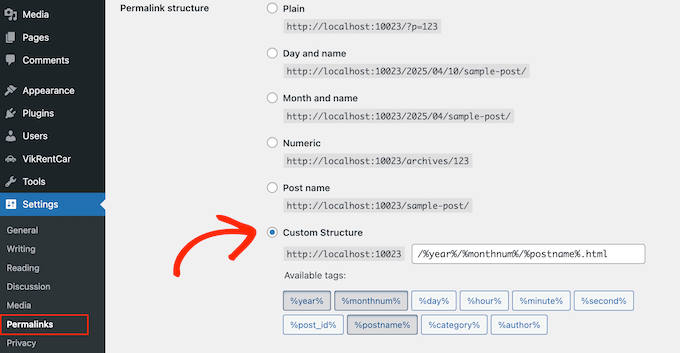
Mit dieser Permalink-Struktur ähneln die URLs Ihrer Blogposts den URLs in Ihrem alten Blogger-Blog.
Es kann jedoch vorkommen, dass die URL Ihres Blogeintrags, in WordPress auch als Slug bezeichnet, nicht mit den von Blogger verwendeten Slugs übereinstimmt.
Um dies zu beheben, müssen Sie ein kleines Codeschnipsel erstellen und ausführen.
Wir empfehlen, diesen PHP-Code mit dem WPCode-Plugin hinzuzufügen. Das ist der sicherste Weg, um benutzerdefinierten Code zu Ihrer WordPress-Website hinzuzufügen. Weitere Einzelheiten finden Sie in unserer Anleitung zum Kopieren und Einfügen von Codefragmenten in WordPress.
1 2 3 4 5 6 7 8 9 10 11 12 13 14 | add_action( 'init', 'wpb_update_slug' );function wpb_update_slug() {global $wpdb;$result = $wpdb->get_results("SELECT post_id, meta_value FROM $wpdb->postmeta WHERE meta_key = 'blogger_permalink' ");$wpdb->print_error();foreach ($result as $row){$slug = explode("/",$row->meta_value);$slug = explode(".",$slug[3]);$wpdb->query("UPDATE $wpdb->posts SET post_name ='$slug[0]' WHERE ID = '$row->post_id' ");}echo "DONE";} |
Nachdem Sie den Code gespeichert haben, brauchen Sie nur eine beliebige Seite auf Ihrer WordPress Website zu besuchen, um dieses Skript auszulösen. Vergessen Sie nach der Ausführung des Skripts nicht, es zu deaktivieren oder aus Ihrer WPCode-Bibliothek zu löschen, da es nur einmal ausgeführt werden muss.
Schritt 4: Umleitungen von Blogger zu WordPress einrichten
Der wichtigste Schritt beim Umzug einer Website ist die Einrichtung einer korrekten Umleitung, damit Sie keinen bestehenden Traffic oder SEO-Rankings verlieren. Weitere Details finden Sie in unserer ultimativen WordPress SEO-Migrations-Checkliste.
⚠️ Wenn Ihr Blogger-Blog eine eigene individuelle Domain anstelle von blogspot.com hat, müssen Sie Ihre Domain-Nameserver möglicherweise auf Ihren Hosting-Anbieter verweisen. Für Anweisungen folgen Sie bitte unserer Anleitung, wie Sie eine individuelle Domain von Blogger zu WordPress wechseln.
Entscheidend bei der Weiterleitung ist, dass Ihre Nutzer auf der neuen Domain auf der gleichen Seite landen, die sie auf der alten Site aufgerufen haben.
Gleichzeitig müssen Sie dafür sorgen, dass die Suchmaschinen verstehen, dass Ihre Website an diesen neuen Ort verlegt wurde.
Dazu müssen Sie das Plugin für die Umleitung von Blogger zu WordPress installieren und aktivieren. Weitere Details finden Sie in unserer Schritt-für-Schritt-Anleitung zur Installation eines WordPress-Plugins.
Nach der Aktivierung müssen Sie die Seite Tools ” Blogger to WordPress Redirection besuchen und auf die Schaltfläche “Start Configuration” klicken.
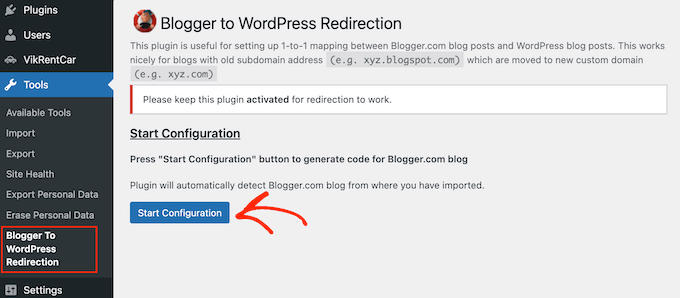
Das Plugin erkennt nun die URL Ihres Blogger-Blogs und zeigt Ihnen die Option an, einen Umleitungscode zu erhalten. Klicken Sie auf die Schaltfläche “Code abrufen” neben Ihrer Blogger-URL.
Es wird nun ein Codeschnipsel generiert, den Sie benötigen, um Benutzer von Ihrem alten Blogger-Blog auf Ihre neue WordPress-Website umzuleiten.
Als Nächstes müssen Sie sich in Ihrem Blogger-Dashboard anmelden und die Seite “Themen” aufrufen. Klicken Sie auf den Dropdown-Pfeil auf der Schaltfläche “Anpassen” neben Ihrem Thema, und wählen Sie dann die Option “HTML bearbeiten”.
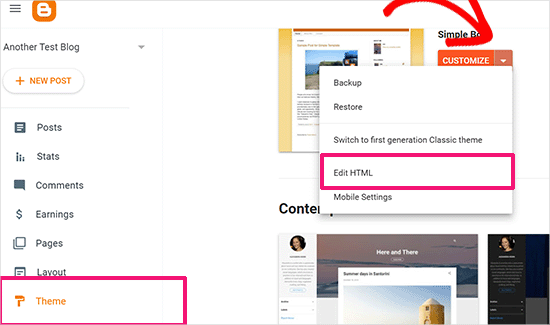
Blogger zeigt nun den benutzerdefinierten HTML-Code für Ihre Themenvorlage an. Wenn Sie Anpassungen an Ihrem Blogger-Theme vorgenommen haben, sollten Sie den Code kopieren und auf Ihrem Computer als Backup speichern.
Andernfalls können Sie einfach alles löschen. Kopieren Sie anschließend den vom Plugin angezeigten Code auf Ihrer WordPress-Website und fügen Sie ihn in den Editor Ihres Blogger-Themas ein.
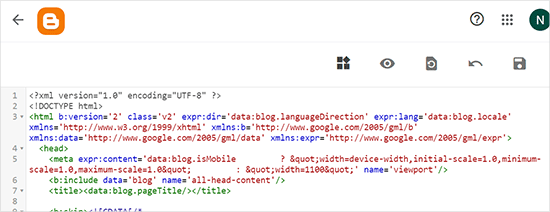
Vergessen Sie nicht, auf die Schaltfläche “Thema speichern” zu klicken, um Ihre Änderungen zu speichern.
Als Nächstes müssen wir Umleitungen für mobile Benutzer einrichten.
Gehen Sie im Dashboard Ihres Blogger-Blogs zurück zur Seite “Themen”. Diesmal müssen Sie auf die Zahnrad-Schaltfläche unterhalb der mobilen Vorschau Ihres Blogs klicken.

Daraufhin wird ein Popup-Fenster angezeigt, in dem Sie die Option “Nein. Desktop-Thema auf mobilen Geräten anzeigen” auswählen müssen.
Klicken Sie dann auf die Schaltfläche “Speichern”.
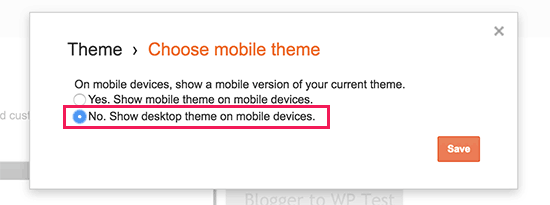
Das war’s. Ihr Blogger-Blog leitet nun alle Besucher Ihres Blogs auf Ihr neues WordPress-Blog um.
Alternativ können Sie auch All in One SEO (AIOSEO) verwenden, um Beiträge und Seiten von Blogger zu WordPress umzuleiten. Das Plugin bietet eine leistungsstarke Funktion für den Weiterleitungsmanager, mit der Sie vollständige Weiterleitungen zu Ihrer neuen Website einrichten können.

Außerdem können Sie die Verfolgung von 404-Fehlern aktivieren und alle defekten Links aufspüren, die bei der Umstellung Ihrer Website auf WordPress auftreten können. Dadurch wird die Benutzerfreundlichkeit verbessert, und Sie verlieren keine Keyword-Rankings.
Wir nutzen AIOSEO, um alle unsere WPBeginner Seiten und Beiträge zu verwalten – und ganz ehrlich? Wir sind von den Ergebnissen überwältigt. Deshalb ist es unsere beste Empfehlung für Sie alle.
Wenn Sie mehr über unsere Erfahrungen erfahren möchten, lesen Sie unsere ausführliche Rezension über AIOSEO.
Schritt 5: Verschieben anderer Inhalte von Blogger zu WordPress
In diesem Schritt werden wir die restlichen Inhalte aus dem alten Blog auf Blogger in Ihren neuen WordPress-Blog verschieben. Dies kann je nach den Einstellungen/Inhalten Ihres Blogs etwas manuelle Arbeit erfordern.
1. Verschieben von Seiten von Blogger zu WordPress
Das Blogger-Import-Tool von WordPress importiert nur Blogger-Beiträge und ignoriert Seiten.
Um Ihre Seiten in WordPress zu übertragen, müssen Sie jede Seite in Ihrem Blogger-Blog bearbeiten, ihren Inhalt kopieren und dann manuell eine Seite in WordPress erstellen.
Um mehr über Seiten zu erfahren, lesen Sie unseren Artikel über den Unterschied zwischen Posts und Seiten in WordPress.
Nun werden Sie auf ein weiteres Problem stoßen. Die Blogger-Seiten haben URLs, die wie folgt aussehen:
http://example.blogspot.com/p/about-us.html
Die URL Ihrer WordPress-Seite sieht dann so aus:
http://example.com/about-us
Um dies zu beheben, müssen Sie das All in One SEO (AIOSEO) Plugin verwenden. Eine Anleitung dazu finden Sie in unserem Leitfaden für Einsteiger zum Erstellen von Weiterleitungen in WordPress.
2. Widgets
Wie Blogger verwenden auch einige WordPress-Themes Widgets, um Inhalte in die Seitenleiste Ihres Blogs einzufügen.
Um Widgets hinzuzufügen, müssen Sie die Seite Erscheinungsbild ” Widgets in Ihrem WordPress-Dashboard aufrufen und Widgets einfach per Drag & Drop in die Seitenleisten ziehen. Ausführliche Anweisungen finden Sie in unserem Leitfaden zum Hinzufügen und Verwenden von Widgets in WordPress.
Wenn Sie ein bestimmtes Widget suchen, das nicht standardmäßig in WordPress enthalten ist, dann benötigen Sie wahrscheinlich ein WordPress-Plugin. Sie können WPBeginners beste WordPress-Plugin-Kategorie durchsuchen, um die gewünschte Funktionalität zu finden.
3. RSS-Feeds
Suchmaschinen und Nutzer, die Ihre Blog-Beiträge über RSS-Feeds abonnieren, können Ihr Blog weiterhin finden. Sie werden jedoch keine neuen Inhalte erhalten.
Um dies zu beheben, besuchen Sie die Seite Einstellungen in Ihrem Blogger-Konto. Scrollen Sie dann nach unten zum Abschnitt “Site-Feed” und klicken Sie auf “Post-Feed-Redirect-URL”.

Daraufhin wird ein Popup-Fenster angezeigt, in das Sie die URL des RSS-Feeds Ihrer WordPress-Website eingeben müssen.
Die URL Ihres WordPress-Feeds sieht dann so aus:
http://example.com/feed
Vergessen Sie nicht, example.com durch Ihren eigenen Domänennamen zu ersetzen.
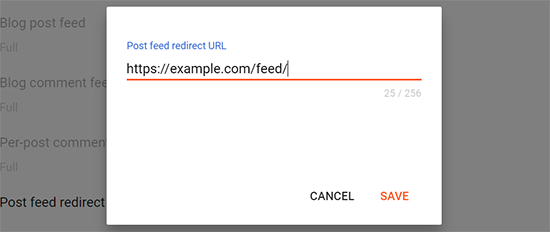
Klicken Sie auf die Schaltfläche “Speichern”, um die URL hinzuzufügen und Ihre Einstellungen zu speichern.
Schritt 6. Was Sie nach der Migration von Blogger zu WordPress tun sollten
Nachdem Sie Ihren Blogger-Blog nun erfolgreich nach WordPress verschoben haben, wollen wir uns ansehen, was Sie noch tun können, um Ihren Blog zu verbessern.
Wir haben eine Checkliste mit den wichtigsten Dingen erstellt, die Sie nach der Installation von WordPress erledigen müssen.
WordPress ist recht einfach zu bedienen. Dennoch werden Sie gelegentlich neue Dinge entdecken, bei denen Sie vielleicht Hilfe benötigen. An dieser Stelle kommt WPBeginner ins Spiel.
WPBeginner ist die größte kostenlose WordPress-Ressourcen-Website der Welt. Wir veröffentlichen regelmäßig Tutorials und Anleitungen, die speziell für Blogger und kleine Unternehmen geschrieben wurden.
Hier sind einige der nützlichen Ressourcen, die Sie auf WPBeginner finden werden (alle sind kostenlos):
- WPBeginner Blog – Der zentrale Ort für alle unsere WordPress-Tutorials und -Anleitungen.
- WPBeginner Dictionary – Unser WordPress-Glossar ist der beste Ort, um sich mit dem WordPress-Jargon vertraut zu machen
- WPBeginner Videos – Neue WordPress-Nutzer können mit diesen Schritt-für-Schritt-Videos beginnen, WordPress zu beherrschen.
- WPBeginner auf YouTube – Brauchen Sie mehr Videoanleitungen? Abonnieren Sie unseren YouTube-Kanal mit mehr als 291.000 Abonnenten und über 50 Millionen Aufrufen.
- WPBeginner Blueprint – Sehen Sie sich die Plugins, Tools und Dienstleistungen an, die wir auf WPBeginner verwenden.
- WPBeginner Deals – Exklusive Rabatte auf WordPress Produkte und Dienstleistungen für WPBeginner Nutzer.
Video-Anleitung
Wir hoffen, dass dieser Artikel Ihnen geholfen hat, von Blogger zu WordPress zu wechseln, ohne Ihre Google-Suchergebnisse zu beeinträchtigen. Vielleicht interessiert Sie auch unser Leitfaden, welchen WordPress-Plan Sie verwenden sollten, oder die häufigsten WordPress-Mythen, die entlarvt wurden.
Wenn Ihnen dieser Artikel gefallen hat, dann abonnieren Sie bitte unseren YouTube-Kanal für WordPress-Videotutorials. Sie können uns auch auf Twitter und Facebook finden.





Mike Oplinger
Ok I’m on step #3 and I’m to the part where I select WPbeginner on my blogger page but I don’t have anywhere to select this, all I have is an option to select the order the page shows up in which is currently 0.
Shell
I had the same issue. The problem was I had put my wpb-blogger.php file into the /public_html/wp-content/themes/ folder instead of in the folder of the specific theme I was currently using. Perhaps the tutorial could state this a little more clearly?
Rebecca
Thank you for this! That was exactly what I was stuck on as well and that worked beautifully!!!
Karen
THANK YOU! I was having the same problem and your suggestion fixed it!
Lori Ketcherside
THANK YOU!!!
mansoor1223
Hi, I just did the same as what is written here, but when i searched google for a post and clicked that Link i am seeing a 404 Not Found Page
Ronamae
How to solve this?
Oops! That page can’t be found.
It looks like nothing was found at this location. Maybe try one of the links below or a search?
Alonso Valdés Morales
I was reading other blogs about this topic, and I got a question. Do I need a custom domain on Blogger.com to make this migration?
Thanks!
WPBeginner Staff
Seems like WordPress is unable to connect with your blogger account. Please check your blogger username and password and try again.
dani
Assalam-u-Alaikum brother Syed Balkhi
When I install blogger importer in wp and then I click Tools>import so I face this error.
Please tell me what happened and how to solve it.
Jazak-Allah and Thanks.
WPBeginner Staff
You can re-run the importer again. It is smart enough not to import posts previously imported successfully.
Awais
I completed all the steps as written. No problem. The one issue I have is that if anyone goes to click on a link from facebook or twitter to read that specific blog article, it takes them to the main WordPress blog page not to that individual blog. Then, they would have to actually search for it by name on the right column. How can this be fixed please? I’ve spent nearly a day trying to figure this out. Thanks.
Shane Carmody
Cheers for this. Almost everything worked great and I didn’t have to do Step 5 as the Blogger importer did it for me. The only gripe I have is that the Blogger importer stalled at the end and it didn’t finish off. Aside from that, redirection works like a charm.
Thanks for the great tutorial.
Melissa
I had to run the importer multiple times, so don’t lose heart!
mariya
i don’t understand I am stuck at the step where i change my blogger template to classic and go into the edit html…i cannot find http://www.example.com in my web address…what am I doing wrong ?? please help ! note i don’t have my own domain name its like
” xyz.blogspot.com”
please help !
jnader
I completed all the steps as written. No problem. The one issue I have is that if anyone goes to click on a link from facebook or twitter to read that specific blog article, it takes them to the main WordPress blog page not to that individual blog. Then, they would have to actually search for it by name on the right column. How can this be fixed please? I’ve spent nearly a day trying to figure this out. Thanks.
Sarah
I have completed the transfer and it all seems great except when I google specific posts it directs me to my new wordpress but the link leads you to one of my wordpress pages, not the individual post. Did I miss a step?
Dok Simon
Am quite confused here .. I have my own paid domain already , how do I export without loosing anything ??
srividhya
This is really helpful. But I am not able to find the permalinks under settings in WP. Where should I change my permalinks?
Thanks
Tiffany Burton
Thank you for a wonderful tutorial. After reading many of the comments and double checking things I still have a question. The redirect links on my blogger site are working great. All my posts have a link now that takes them to my new wordpress site. The problem is when I get there instead of taking me to the matching post my wordpress site says:
“Well this is somewhat embarrassing, isn’t it? It seems we can’t find what you’re looking for. Perhaps searching, or one of the links below, can help.”
Everything imported correctly and the posts are there. What part did I do wrong? I have the blogger page made and uploaded my php file via filezilla without a problem. I even found a plugin to let me exclude pages from my sites navigation bar. This is my first time ever typing code of any kind could that be the problem? I am just wondering what I need to do from here.
Wilson Pina
Another HQ post! Of course, we couldn’t expect Anything else from the good folks @ WP Beginner ))))
Balaji
cleared all my doubts thanks
thanks
Mark
Great article – thanks. Just one issue I’m having is that I have to use custom permalinks in WordPress so they don’t match from blogger:
WP: [domain]/%year%/%postname%/
Blogger: [domain]/%year%/%month%/%postname%.html
Any idea where/how I can change this?
WPBeginner Staff
Please make sure that you have modified the blogger template correctly and that it is redirecting users to the blogger page on your WordPress site.
Also make sure that the blogger page is using the wpb-blogger.php file as its template.
If all of this seems right, then check the URL you are directed to and compare it with the post’s URL on your WordPress site. Report back with more information and we will try to figure this out.
Kristiyan Bogdanov
Ooops. I forgot to make the page. Now its all fine. Works perfectly! Is it safe to hide or delete the page now?
Diana
Thanks for these instructions, I have to admit i have four this a HUGE learning curve. Ive followed all of your steps to the letter, but now am at the end of Step 3. I have created a new page, but don’t get the WP Beginner Blogger option on drop down. Did I miss a step somewhere. any help would be much appreciated.
Aljaž Ribnikar
Thanks for this tutorial. I did all steps above but there is something wrong with redirection. My new wordpress blog is on sub directory of my online shop (shopurl/blog) but if I visit old post on blogger it will redirect me to my root domain (online shop) and not to my wordpress blog post. My old blogger was on sub domain of this same online shop (blog.shopurl).
Guest123
Hi, I had recently started on blogger and now trying to make the switch to wordpress. I am trying to import blogger content to wordpress but having issues. When I am on blogger>setting>blog tools and I click on export blog, and click on the option to “download blog” an error comes up saying “safari could not update this feed because the source file is no longer available”. How do I fix this so that the contents I have on blogger is moved to wordpress? thank you!
Aljaž Ribnikar
Hi! Thanks for your tutorial! Everything worked great, except redirects from blogger post to wordpress post. I have online store on some other platform and separate installation for wordpress blog on subdir of my online store. My blogger blog is on http://www.blog.mywebstoreurl.com. Now I am moving from custom blogger domain to wordpress subdir on my website: http://www.mywebstoreurl.com/blog/. I did all steps above but when I open old blogger post it will redirect me to my website root (www.mywebstoreurl.com) not even to blog (www.mywebstoreurl.com/blog/). If I open old blogger root page it will redirect me OK to http://www.mywebstoreurl.com/blog/. I hope I didn’t complicate it too much:) Any idea?
eL-hAkeeM
I’ve followed your instructions but still can’t get my embed videos back,,
can you tell me how to fix it??
WPBeginner Staff
We will look into it and update the article.
Jason Knoell
Is there any update on this? I realize you’re not my personal support line but I do need to find a fix for this ASAP…
but I do need to find a fix for this ASAP… 
Angelo
Jason, did you find any solution?
Angelo
I have the same problem. Mobile version is still showing. Also when using an old article link it reffers only to the home page of the new wordpress site. Hoping for help.
Jason Knoell
This is fantastic and works like a charm without loading in more plugins. Thank you! However…. When I visit the site on my iphone, it doesn’t redirect me. Is this because it’s a mobile verion of the blogger site? Is there a way to catch that too?
WPBeginner Staff
Adrain you should remove it from your site’s navigation menus or sidebars. The purpose of this page is to redirect users coming from blogger to correct posts in WordPress.
Making a page private will make it inaccessible. This means users coming from blogger will not be redirected.
Adriane
After creating the page labeled “Blogger” and using the WP Beginner theme, what is the purpose of the page and should it be displaying anything? When I click on it I just see a white screen.
WPBeginner Staff
The purpose of this template is to redirect users coming from blogger to correct posts on your WordPress site.
Adriane
Is there something wrong if it leads me to a blank white screen when I click on the blogger tab? Can I make it private or should it remain visible? Thanks!
Lauren
So happy I found this post. I think it’s time to make the switch.
Amber K. Sanders
This article was helpful, but I do have an issue. I want to add a “blog” menu tab that will then allow clients to be on my site and read additional posts. How can I get my posts to show up when I add a new page?
WPBeginner Staff
Seems like redirection is not working, please make sure that you haven’t missed anything.
Cathy
I’m having the same issue, although I’m getting a 403 error. When I test a link from the old blogger site, the address in the bar changes to something like http://www.newblog.com/blogger/?q=http://www.oldblog.blogspot.com/2014/04/old-blog-post-title.html which results in the 403. I’m pretty sure I’ve followed all the steps noted, can you advise? Thanks!
Cathy
I wanted to reply to my earlier post, because I found out what the issue was. The new WordPress blog is hosted on Hostgator, and that particular host has some changes that need to be made in order for this Blogger–>Wordpress technique to function correctly. If you contact tech support there, they can assist with it.
John Potenza
Can you tell me what exactly they did, or do you have no idea? I also have hostgator, would love to know.
Andrea @ Why Roam?
Hi, thank you for this post! The instructions were very easy to follow. Everything has worked perfectly for me. However, once I tested a link from my old blogger site, I received a 404 not found error. I’ve tried several posts and receive the same error. If I do a site search, the old post comes right up. Any advice?
Kristiyan Bogdanov
Same problem here! @wordpressbeginner:disqus, Please help!
Satya
I have a blogger blog having custom domain name. I followed all the steps above..but the issue is still my blogger post redirected to home page(wordpress blog) only..Plz help..
Helen
Sorry – I’ve fixed it. The main issue for other users is finding the right folder to put the php folder in. Not easy and you may have to contact your host support as I did.
anu
I do have another question as well…do you know how I can move my blog followers to wordpress site? is there a plugin?
anu
This is a very helpful post…thank much for sharing…I have a question here,….this will move only the post, comments and the media right? but it does not do anything to move the blog pages to the wordpress….is there a way to move the pages and it’s contents as well?
I still didn’t do the redirection …as I was not sure if I need to do more changes with respect to the pages in wordpress.
Please help.
Mahesh Waghmare
Nice article, Thanks.
Sharron Goodyear
I have followed your instructions up to the point before saving the php file. I went into Edit HTML and deleted the code that was there and replaced it with what you have listed above. I then saved the template.
However now when I try and access the ‘Edit HTML’ I get the following error message:
We’re sorry, but we were unable to complete your request.
When reporting this error to Blogger Support or on the Blogger Help Group, please:
Describe what you were doing when you got this error.
Provide the following error code.
bX-4b250i
This information will help us to track down your specific problem and fix it! We apologise for the inconvenience.
Close
Please could you tell me why this might be as this is causing a major issue for me!!
Many thanks
Sharron
WPBeginner Support
Wait for a while and then try again. Remember that your posts on your blogger site are perfectly safe and you can always go back to Templates and restore your blogger blog.
Admin
marielle altenor
I’m in the process of moving my blogger site to wordpress.org. My question has to do with Google Analytic. Do you have a post that talks about how to go about it? Would I be using the same profile for my new wordpress.org blog or create a new one and start the page view and such from the start?
WPBeginner Support
Marielle, yes we do have a Google Analytics setup guide. You can use the same Google account. However, since this will be a different domain name, you will have to create a new site profile for it.
Admin
Avadhesh
What if i also want to move the domain too.
Tanja Jensen
Hi there! The quality is not good…. But all the images did import into my media library.
The quality is not good…. But all the images did import into my media library.
After I imported my blog, all my images are looking bad
Can I do something that will update all the images in my posts or do I really have to go through every single post manually?
– Tanja
WPBeginner Support
Tanja if you have successfully imported images to your media library, then you probably need to regenerate images.
Admin
Tanja Jensen
Hello again! Well, it did help me with my thumbnails, but my pictures in my posts still look grumsy. I have tried to upload the same picture again directly from the media library, but I really do not want to go through all my 300 posts if I can help it! See example here: Can you see my problem?
Tanja Jensen
Oh…. I can see that the URL of the image is the old IP address from WordPress – I guess it should be custom domain? Can I change that in a quick way?
WPBeginner Support
You can try importing the external images. After that you need to run the regenerate thumbnails script once again.
Tanja Jensen
Hi there
I have a problem with Step 3. I cannot see my .php file unde ‘Template’ when creating the new page titled ‘blogger’. What may I have done wrong?
– Tanja
Tanja Jensen
Uh, I think I fixed it. Just had the place the file in some sub directories = the right place Although a bit hard to figure out since there are many main and sub folders in my FTP client! Hard for a beginner to figure out… – Tanja
Although a bit hard to figure out since there are many main and sub folders in my FTP client! Hard for a beginner to figure out… – Tanja
Adriane
I’m having the same problem. Where do you end up needing to put it?
TIffany Ima
This is a great tutorial, except it doesn’t explain how to add the file to the theme directory, and I am completely lost. I cannot get my post to redirect appropriately.
WPBeginner Support
Tiffany, you need to use an FTP client to upload the file to your theme directory.
Admin
Tanja Jensen
HI there! I am about to move my blogspot blog to WordPress – YAY! But before I do that, I want to make sure about one thing: when I import my blog from blogspot to WordPress, will I then delete it on blogspot or just copy it? I mean, if something goes wrong, I want to be able to go back to my blogspot to continue making posts until I get the WordPress to work. I haven’t seen the ‘inside’ of the WordPress admin panels, so I don’t know how it all looks. I mean, do I have a special section called ‘posts’, where I write post, edit my old ones etc?
I haven’t seen the ‘inside’ of the WordPress admin panels, so I don’t know how it all looks. I mean, do I have a special section called ‘posts’, where I write post, edit my old ones etc?
Another question – when I import my blog, where will WordPress import my blog posts – to a particular page or to specific WordPress posts? And what about my tags/labels or what you call it here… I depend a lot on my division on tags
Thanks for the help! – Tanja
WPBeginner Support
Tanja, this guide does not ask you to delete any posts from your Blogspot site. This method only redirects users coming to your blogger site to your WordPress site. Your blogger posts should remain as they are and if you wish you can always switch back your blogspot template and your blogger site will be live and accessible again.
Admin
Tanja Jensen
Good to know, I was just worried about what was meant by the word ‘import’ – delete or copy I am a beginner (as most others looking at this site), so I just wanted to make sure – that I could still run my blog while I was setting up the WordPress version of it. Thanks for the help!
I am a beginner (as most others looking at this site), so I just wanted to make sure – that I could still run my blog while I was setting up the WordPress version of it. Thanks for the help! 
Bob Jones
I have the same problem that Rachelle, above, has. When I then go to create a page in WordPress, WPBeginner Blogger does not come up as an option in the templates. My only options are “Default Template,” “Contributor Page,” and “Full Width Page.”
Any post I view on Blogger now shows the text of this page, concatenated in a continuous line of text.
Help!
Bob Jones
Salem, Oregon
WPBeginner Support
Bob, it seems like the template file is missing theme, which is causing WordPress not to recognize the template file. Please copy pase the code again.
Admin
Bob Jones
Thank you for your reply to my question. I copied the code in the first block under step 3 into my blogger template. I then copied the code in the second block of step 3 into a wpb-blogger.php file and uploaded that file to the server directory containing the WordPress files. I see that WPBeginner Blogger is the name of that template.
What happens now when I click on a post in a Google search results page listing is that I get sent to the blogger page I created in step 3. I do not get sent to the post that was shown on the results page.
Also, I still do not have WPBeginner Blogger as a choice in the Page Attributes / Template drop-down box.
Getting closer, but still not there.
Bob Jones
Salem, Oregon
David Reber
Did something change in the newer versions of WordPress. I needed to add the Page Theme plugin to allow for a different theme to be used on different pages.
Farhan
Thanks for the great article, I want to move my blogger site to wordpress but want a new perma link structure.
So instead of a date based system i.e. year/month/blog title like 2014/03/tutorialA.html I want to change it to /tutorials/3Dsoftware1/tutorial1.html
Is there a code solution that I can implement in the head of the blogger file or in each post’s html version to target my old blogger posts to my new wp site? Each post will now be listed by its categoryName/post_title.
Perhaps I should create two posts i.e. do the straight forward conversion then apply category based URI with a 301 redirect? I imagine not as there will be an extra duplicate post.
Thanks so much
Asdrubal Romero
I have done all up to the point of setting redirection at wordpress. You say that i have to upload a file but i do not even know how i do that. What is the ftp direction of wordpress and do they have a reserved space for each user?
WPBeginner Support
First make sure that you are on a self hosted WordPress.org site and not WordPress.com blog (see the difference). After that you need to contact your web host to find out your FTP account user name and password. In case you don’t want to use FTP, some web hosts also offer a file manager available on your cPanel dashboard.
Admin
nil
Hey,
I would only like to change the rel=canonical URL from my old blogger blog to my new blog, not redirect everything. Do you know how? That would be great!
Just tried few manuals from the net, nothing works anymore.
Thanks
nil
Rachelle
Hello,
I’ve been able to import my blogger posts (except the very first post, which I still cannot figure out why it didn’t import) to my hosted WordPress account. I was able to get everything to work–including the Blogger redirect–until I reached the step where you have to setup the redirect for WordPress itself so that each individual post on Blogger is redirected to the new location on WordPress. I created the PHP file and pasted in the code exactly as was posted above. I then uploaded the file to the theme folder where the WordPress files are on my account. However, when I then go to create a page in WordPress, WPBeginner Blogger does not come up as an option in the templates. My only options are “Default Template,” “Contributor Page,” and “Full Width Page.”
I’m at a total loss as to where I went wrong. Any ideas on how to correct this issue? I don’t want people clicking on a direct link to one of my Blogger articles to see a “Page Not Found” error.
Thanks!
Glenn
I have the same problem: I uploaded the file and the WP Beginner template does not show as an option. Can someone share a solution?
WPBeginner Support
Please make sure that you have created the template file in /wp-content/themes/your-theme-directory/
Admin
Glenn
I *think* we’re getting close, but it’s still not working. Hmm, do I need to do anything differently if my wp blog has a different title than my blogger blog:
blogger name: autismplusmath.blogspot.com
wp name: autismpluslande.com
THANK YOU for your continued help with this: appreciate the quick reply to my last query!
Emma
I have tried everything on redirect from blogger and I get this error:
Error parsing XML, line 2, column 73: The value of attribute “dir” associated with an element type “html” must not contain the ‘<' character.
can you help please?
WPBeginner Support
Emma, it seems like you are pasting the blogger template code in the wrong location.
Admin
Dino
Hi,
I have a self hosted blog WordPress on Bluehost and I’m trying to migrate contents from my old Blogger blog.
I did the export step from Blogger, but when I’m on my wordpress dashboard, I do tools>import, then a completely white page appears.
What can I do?
Thanks.